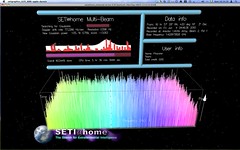-

- Image by Angelo Finucane™ via Flickr
One huge example of the advances made in computer hardware and technology is the LOFAR radio telescope which went on-line in June 2010. LOFAR stands for Low Frequency Array. It is located in the Netherlands but reaches far over into Europe. LOFAR is the world’s largest radio telescope, but what is truly special about it, is its fundamental design principle. It does not rely on mirrors or the focusing of mirrors. Rather it uses thousands of radio antennas to send digitized signals via fiber-optic cables to a supercomputer, the Blue Gene/P. This computer looks at all the various data it receives and ultimately develops a highly-detailed synthetic image of outstanding quality.
While all telescopes today are computerized, LOFAR has gone further. LOFAR is in fact a computer which has been designed to function as a telescope.
LOFAR incorporates over 25,000 radio antennas that have been situated throughout the Netherlands and in Europe, providing for outstanding image resolution and detection sensitivity. The flexibility that the telescope affords astronomers is unique; the ability to seek out ultra high energy cosmic rays, weak radio emissions, other varied radio signals and even the possibility of discovering signals from a SETI (Search for Extra-Terrestrial Intelligence) source. However a primary function will be LOFAR’s ability to peer into the early period of the universe.
Observing the night sky and the stars is literally looking back in time. By observing a galaxy like Andromeda, we are looking back perhaps several million years. But LOFAR will be able to look back a great deal further in time than that. In fact it will be able to look back even further than the Hubble Space Telescope did.
And all that promise comes at a cost-effective price. LOFAR clocks in at an estimated cost of one hundred fifty million euros or roughly one percent the cost of the Hubble.
LOFAR has set the standard for future growth in radio astronomy into the twenty-first century.